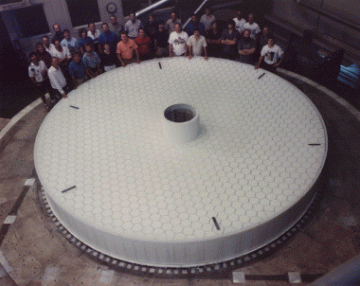On the night of April 2, 1992, the Steward Observatory Mirror Lab transformed 10 tons of glass into a 6.5-meter mirror blank. This casting marked the first time in nearly 60 years that US. astronomers had attempted to make a telescope mirror of such large dimensions. Previously, the last casting made in the US was in 1934 when the Corning Glass Works cast the 5-meter (200-inch) mirror for the famous Hale Telescope on Palomar Mountain in California.

It took about six months to assemble and test the mirror mold on the open furnace floor. Over 10 tons of Ohara E6 glass, in pieces typically of 4-5 kg, were inspected and hand loaded into the mold on March 17-18, 1992, and the furnace dome was lowered into place a few days later. The furnace was started on March 29, 1992, and took several days to reach the casting temperature that, at its maximum, registered more than 2100 F (~1150 C).
By April 2, 1992, the glass had started to soften and the furnace began to rotate at 7.4 rpm. That evening, the glass had the consistency of honey, and during a 12-hour period flowed over, between, and underneath the cores that lined the mirror mold.
After a three-month cooling cycle, room temperature was reached on June 25, 1992, and a door leading into the furnace was opened, affording the Mirror Lab team its first look at the newly cast mirror blank. A few days later, the furnace dome was removed by overhead crane and the walls of the mirror mold were dismantled. On October 30, 1992, the mirror blank was moved by crane from the furnace floor to its holding ring in preparation for cleaning.
With the mirror blank turned on edge, the mold tiles were unbolted from its back suface and a high-pressure water jet was aimed into each bolt hole. In this way, the delicate alumina-silica core material was broken up and flushed out, leaving behind a hollow, lightweight honeycomb glass structure.

